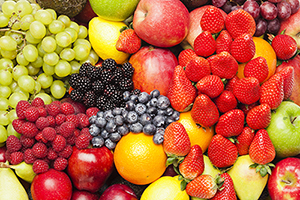Is fructose the demon-spawn?
Let’s cut through the confusion . . .
There’s long been a symbiosis between humans and fruit. Ancient fruit provided sustenance to humans—not that the fruit cared. Its evolutionary impetus to be sweet and attractive was to entice paleo humans to consume it, and then spread its seeds far and wide, thus extending its geographical range as a survival strategy.
In turn, fruit nourished humans, not merely with calories, but also with beneficial polyphenols. This ensured that bipedal seed-dispersers would remain healthy and mobile.
But paleo fruit was paltry and seasonal, often requiring high energy expenditure to acquire. Current varieties are the products of intensive breeding and hybridization designed to amp up size, palatability, and sweetness. Hence their sugar content is a far cry from that of their ancient predecessors. And thanks to the marvels of modern transport and refrigeration, they’re ubiquitous yearlong.
From fruits we get fructose. That and honey were our main sources of fructose until the 1960s, when food processors tapped the bounty of inexpensive U.S. corn. This coincided with the geopolitical constraint of our estrangement from Cuba, a major exporter of sugar cane. HFCS is cheaper to make than table sugar, which now comes mostly from sugar beets—of which the U.S. is second only to Russia in cultivation. 95% of sugar beets are GMO, as is corn.
(Fructose Facts: The sugar in “Natural” agave syrup is 70% fructose; honey 50%; and orange juice 30%.)
High-fructose corn syrup (HFCS) is the product of enzymatic processing of corn starch, which is composed of a necklace of glucose molecules. HFCS is actually a mixture of two simple sugars—fructose and glucose—in a 42:58 mix in processed foods, cereals, baked goods, and some beverages; in soft drinks, it’s a 55:45 mix.
This poses three problems: The first is the quantitative leap in fructose consumption that the ubiquity of HFCS represents; the second, is that unlike table sugar, which is sucrose, comprised of a 50:50 mix of fructose and glucose, HCFS delivers its fructose load more readily because no chemical bond joins the glucose and fructose. And finally, the entirety of U.S. surplus fructose consumption now comes from the addition of HFCS to non-traditional, highly palatable, ultra-processed foods.
HFCS use in the U.S. began in the late 1960s and peaked in the late 1990s. There was a skyrocketing availability of HFCS from 4 to 12 to 36% of total sweeteners across the 10 years from 1975 to 1980 to 1985; between the 1977–1978 Nationwide Food Consumption Survey (NFCS) and the National Health and Nutrition Examination Survey (NHANES) study conducted 1999–2004, per capita availability of HFCS increased 60.8%. From 1985 to 1993, HFCS increased to 67.7 grams per day; then from 1994 to 2005 HFCS availability increased to 73.4 grams per day per capita. Sucrose, HFCS, and “other” sweeteners accounted for 44, 42, and 14%, respectively, of total sweeteners in 1999, and these percentages have remained constant since then; this resulted in daily energy and carbohydrate intake increases of 18 and 41%, respectively; the net effect was that from 1978 to 2003, estimated per capita total sweetener availability increased 16.6%. (Source)
High-octane fructose in these amounts was never ingested by humans in their entire history, spanning hundreds of thousands of years of gradual evolution.
Understandably, many authorities have called out novel HFCS as the prime driver of the enormous increase in overweight and obesity in Americans, producing an epidemic of metabolic syndrome and diabetes.
You’ve learned from listening to my podcast episodes with Dr. David Perlmutter, author of Drop Acid, about the relationship between excess dietary fructose and elevated uric acid, and hence, gout. But Dr. Perlmutter, a neurologist, implicates uric acid as a causative agent, not just of painful joint problems, or even obesity, but also of neurodegenerative disease.
In an elegant article in the American Journal of Clinical Nutrition, Perlmutter and his co-authors propose a mechanism by which uric acid, hiked by seasonal availability of fruit, enabled prehistoric humans to store fat as a hedge against winter deprivation. But driven by its surfeit in the modern diet, fructose may now stoke progression to Alzheimer’s Disease:
“ . . . this survival mechanism has a major role in the development of Alzheimer’s disease and may account for many of the early features, including cerebral glucose hypometabolism, mitochondrial dysfunction, and neuroinflammation.”
A brand new study confirms this: Not surprisingly, higher sugar-sweetened beverage intake was associated with a higher risk of dementia.
“Sports drinks” represent an insidious source of HFCS; A 20-ounce container of Powerade® delivers 35 grams of carbohydrates from HFCS. The first ingredient in Ensure® Original powder is “corn syrup”—a euphemism for HFCS—accounting for 13 of its 34 grams of carbohydrates per serving (the rest is from maltodextrin).
Unlike glucose, which is readily utilized as a fuel by all the tissues of the body—heart, brain, muscles alike—fructose is metabolized almost entirely by the liver. Therefore, fructose may be a prime instigator in non-alcoholic fatty liver disease, the incidence of which is soaring. A recent review cites “the negative and detrimental effects of high fructose on the liver, with special reference to metabolic disorders . . . fructose is two to three times more potent than glucose in increasing liver fat.”
Excess fructose is also associated with GI symptoms in many individuals; reduction or elimination of fructose can alleviate gas, bloating, cramping, and diarrhea in many individuals. (It’s one of the “M’s”—monosaccharides—in the low-FODMAP diet for IBS.)
Additionally, it’s thought that the unique biochemical properties of fructose accelerate glycosylation—the protein-damaging process by which age-related glycolytic end-products (appropriately abbreviated AGEs) promote organ dysfunction and senescence.
Finally, as pointed out by former FDA whistle-blower Renee DuFault (a recent guest on the Intelligent Medicine podcast) in her book Unsafe at Any Meal, the industrial processing by which HFCS is manufactured may yield traces of toxic mercury.
So clearly, it’s in our interest to shun fructose-laced ultra-processed foods and HFCS-sweetened soft drinks. But what about fruit?
A new study sheds light on that question. And, to some people’s likely surprise, it showed a beneficial effect of fruit consumption on weight and even BMI. It even demonstrated that small amounts of dried fruit didn’t fatten people up. Nor did much-maligned fruit juice.
The caveat was that fruit and juice had to be consumed in moderation—less than 5-10% of total energy intake. Fruit was best handled by the body as a substitute for other processed sugary foods.
This may not square with ultra-low carbohydrate or keto diet regimens, where the inclusion of even tiny amounts of sugars can undermine success. Some people stall in their weight loss progress when fruit becomes a calorie loophole. From big studies like the one cited above, it’s admittedly hard to generalize—when it comes to fruit consumption, some people may require lower thresholds.
Fruits are yummy—but not nearly as hyper-palatable as highly-processed faux foods and beverages. For some with uncontrollable carb cravings, fruits may act as gateways to sugar benders. But for the most part, since fruits are included in a fiber matrix, their glycemic impact is lessened. Moreover, they deliver beneficial polyphenols, many of which have salutary metabolic effects. In fact, the proanthocyanidins in berries and grapes have been found to fend off cognitive decline.
When recommending fruit, I generally suggest unsweetened berries, kiwis, fresh figs or grapefruit. Don’t forget, low glycemic index avocadoes are considered a fruit.
BOTTOM LINE: Not all fructose is bad. Don’t confuse artificial high fructose corn syrup with the natural sugars present in fresh fruits, which can usually be consumed in moderation, providing you’re metabolically healthy.







